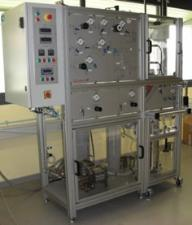Natural gas transportation
Natural gas is the third most widely used source of energy in the world after oil and coal and one of the least polluting in terms of greenhouse gas (GHG) emissions.
More than 30% of global production is provided by the European continent. Natural gas is transported across Europe over a transport network of more than 50,000 kilometers owned by several different European gas companies. In all countries, gas is distributed to customers (industries, distribution companies) through a gas expansion station. During this operation, a solid deposit may appear and jeopardize the safety of the installations.
Studies conducted at LaTEP, particularly thermodynamic characterization, have provided a better understanding of this phenomenon.
The bibliographic review of the different deposits that can occur in natural gas rapidly drew out attention to highlighted sulfur. Three hypotheses were put forward for the formation of suplfur: a chemical reaction, condensates and desublimation. The precise location of the deposit after gas expansion, its absence upstream, and the extremely short residence time, all indicate that the formation of solid sulfur is not the result of a chemical reaction controlled by kinetics. The hypotheses that the occurrence of sulfur was, based on condensate formation and sulfur desublimation appeared to be the most likely. We then performed a thermodynamic characterization of the system to study the various hypotheses of solid sulfur formation. The description of solid sulfur fugacity was a blocking point. We then established an new thermodynamic path allowing us to achieve a full understanding of the system. Similarly, the numerical processing the appearance of the phases was a sensitive point in the development of our models. We used an original algorithmic approach that allowed us to automatically control the appearance or disappearance of phases.
Sulfur balance cell
In the particular pressure and temperature domains we were interested in, experimental data on sulfur solubility in a gas phase available in the literature were extremely rare, if not non-existent. The binary interaction coefficients of the equation of state were regressed from experimental data obtained in much higher P and T domains than those of the application. To work around this lack of data, in 2005 we launched the design and development of an experimental pilot to study the solubility of sulfur, first in binary gaseous systems (to obtain binary interaction parameters) and then we extended the study to systems with more complex gas compositions. Today, the pilot in an optimal configuration that enables us to experimentally obtain sulfur solubility data in methane up to near-atmospheric pressures.
Currently, we are one of the few laboratories in the world to have these competencies . We would now like to extend studies to to gaseous systems whose compositions comprise H2S. A laboratory adapted to the safe handling of this such compounds is currently being designed within UPPA and the IPRA federation.
The competencies acquired, in modeling as well as in experimentation for the characterization of complex systems, have recently enabled us to apply them successfully to the field of geosciences, e.g. CO2 storage or deep geothermal energy with, for example, the study of the solubility of gases in brines under high pressure.


